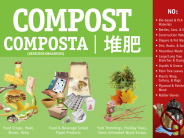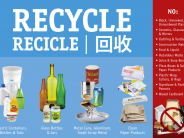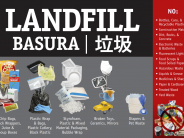Reduce Waste
Para ver en español, haz clic en "Select Language" en la parte inferior de la página y selecciona "Spanish"
Rethinking how we deal with waste is a key part of maintaining a healthy environment and a clean city. Even something as simple as putting trash in the right bin can avoid pollution and reduce emissions. Reducing the amount of waste we produce or repairing/reusing items can go even further to help save money and avoid the environmental impacts of producing so many disposable products. See below for more information on how and where to get rid of trash, food recovery efforts, and other efforts to reduce waste.
Sorting waste
Properly sorting waste is a powerful way that you can make a difference for the environment by reducing pollution that ends up in the food we eat and avoiding harmful methane gas emissions.
Standard waste
Some commons items that go in each bin include:
- Compost/Green — Food scraps, plant/yard waste, paper or cardboard food containers
- Recycle/Blue — Clean paper, cardboard, numbered plastic, glass, metal, foil
- Trash/Black or Gray — Wrappers and plastic film, styrofoam, diapers
For other items or if you are uncertain, check the Recology website to look up which bin it goes in.
Large items
Large items such as furniture or a large amount of bagged trash can be picked up by scheduling pickup with Recology. It is free twice a year. Apartment tenants must contact landlords to schedule pickup.
Hazardous waste
Hazardous waste includes electronics, batteries, fluorescent lights, medications, motor oil, and treated wood which each need to be disposed of differently. See here for instructions for houses and apartments.
The City also organizes hazardous waste drop-off events occasionally throughout the year — sign up for the Sustainability Newsletter or the City Newsletter for updates.
Reuse and repair
Food recovery
As part of state efforts to reduce food waste, San Mateo County runs a large-scale food recovery program, preventing waste and helping get groceries and meals to local families.
For families, see the Second Harvest website for more information on free groceries and meal distribution locations in East Palo Alto.
For businesses, see here if you are required to participate in the program.
Reporting Dumping
To report items dumped or abandoned in the public right-of-way, please email the Clean City Program at cleancity@cityofepa.org



